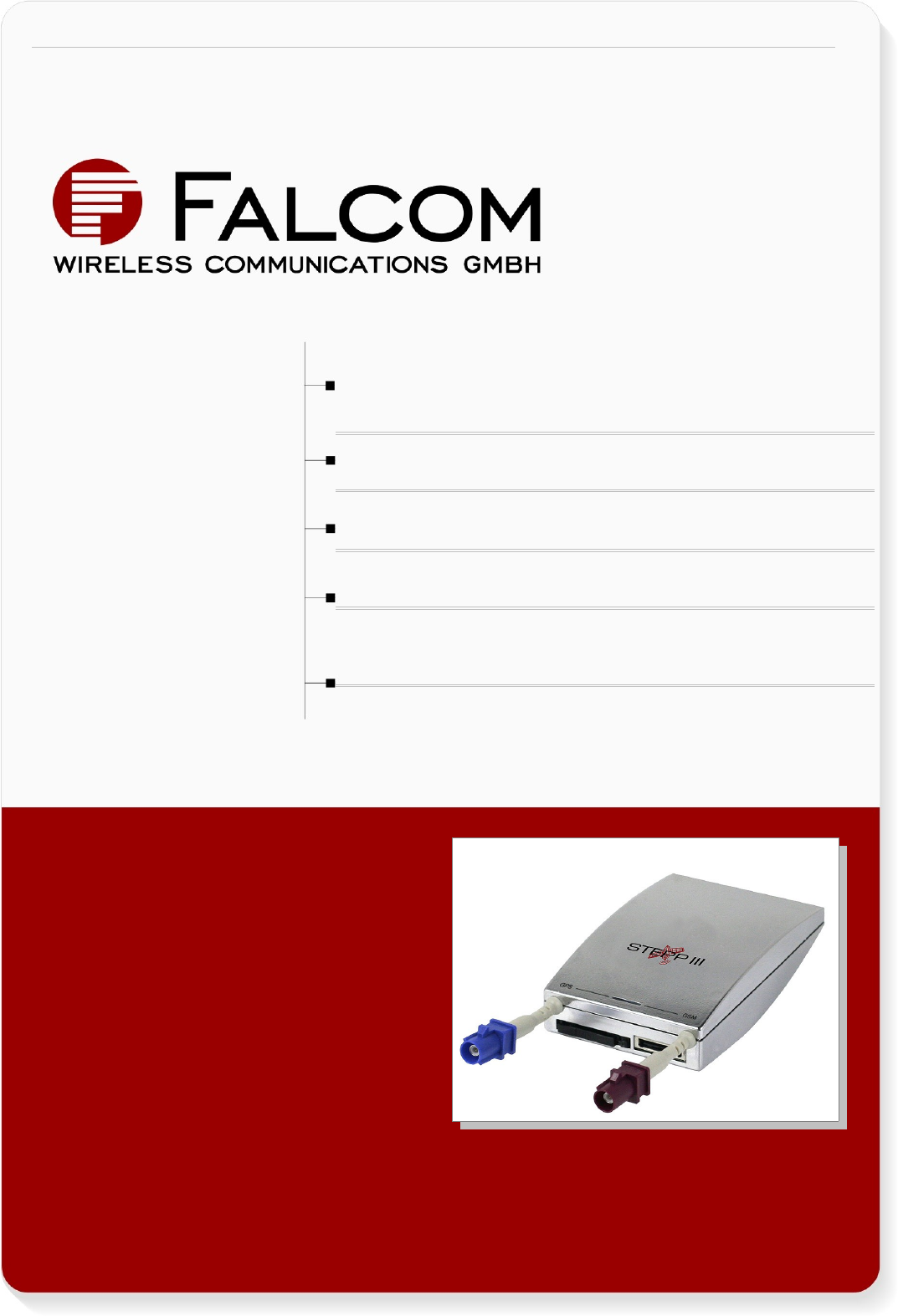Falcom STEPPIII GSM/GPRS/GPS unit User Manual Vorlage
Falcom GmbH GSM/GPRS/GPS unit Vorlage
Falcom >
UserMan

STEPPIII Hardware description Version 1.0.0
Index of contents
1 INTRODUCTION ........................................................................ 6
1.1 GENERAL ..............................................................................................................6
1.2 CIRCUIT CONCEPT ...................................................................................................8
1.3 USED ABBREVIATIONS .............................................................................................. 9
1.4 RELATED DOCUMENTS ..............................................................................................9
2 SECURITY ............................................................................... 10
2.1 GENERAL INFORMATION .......................................................................................... 10
2.2 EXPOSURE TO RF ENERGY ..................................................................................... 10
2.3 EFFICIENT MODEM OPERATION .................................................................................. 11
2.4 ANTENNA CARE AND REPLACEMENT ............................................................................11
2.5 DRIVING ..............................................................................................................11
2.6 ELECTRONIC DEVICES .............................................................................................11
2.7 VEHICLE ELECTRONIC EQUIPMENT .............................................................................. 11
2.8 MEDICAL ELECTRONIC EQUIPMENT ............................................................................. 11
2.9 AIRCRAFT ............................................................................................................12
2.10 CHILDREN ......................................................................................................... 12
2.11 BLASTING AREAS .................................................................................................12
2.12 POTENTIALLY EXPLOSIVE ATMOSPHERES .................................................................... 12
2.13 NON-IONIZING RADIATION ...................................................................................... 12
3 SAFETY STANDARDS ............................................................ 14
4 TECHNICAL DATA .................................................................. 15
4.1 GENERAL SPECIFICATIONS OF TERMINAL STEPPIII ..................................................... 15
4.1.1 Backup Battery Technical Data (1100 mA/h) .............................................. 17
4.1.2 Power consumption ..................................................................................... 17
4.1.3 Operating temperatures .............................................................................. 17
4.2 TECHNICAL SPECIFICATIONS OF GSM/GPRS ENGINE ...................................................18
4.3 TECHNICAL SPECIFICATIONS OF GPS RECEIVER ............................................................19
4.4 NMEA DATA MESSAGE .......................................................................................... 20
5 STEPPIII APPLICATION INTERFACE .................................... 21
5.1 POWER SUPPLY .................................................................................................... 21
5.1.1 Power supply pins (15 and 16) on the MOLEX 16-pin connector ................ 21
5.1.2 Automatic shutdown .................................................................................... 21
5.2 DETERMINING THE EXTERNAL EQUIPMENT TYPE ...........................................................21
6 HARDWARE INTERFACES .................................................... 22
6.1 INTERFACE A (16-PIN MOLEX 43045-1609) ............................................................ 23
6.1.1 MOLEX connector pinout ............................................................................ 23
6.1.2 Special pin description ................................................................................ 24
6.1.2.1 Analog inputs (2, 4, 6, 8) ......................................................................................................... 24
6.1.2.2 Digital Inputs (pin 10,12) ......................................................................................................... 25
6.1.2.3 Outputs (pin 5, 7, 9, 11) ......................................................................................................... 26
6.1.2.4 Ignition (pin 13) ....................................................................................................................... 27
6.2 INTERFACE B (SIM CARD INTERFACE MOLEX-91228-0002) .........................................27
This confidential document is a property of FALCOM and may not be copied or circulated without previous permission.
Page 2

STEPPIII Hardware description Version 1.0.0
6.3 INTERFACES C AND D ............................................................................................ 28
6.4 INTERFACE E (AMP 558556-1 CONNECTOR) ...........................................................29
6.4.1 AMP connector pinout ................................................................................. 29
6.4.2 Special pin description ................................................................................ 30
6.4.2.1 VC 5 ........................................................................................................................................ 30
6.4.2.2 Serial communication signals (RxA, TxA and Rx4, Tx4) ........................................................ 30
6.5 INTERFACE F (LED’S DESCRIPTION) ..........................................................................31
6.6 INTERFACE E (MOUNTING HOLES) ............................................................................. 31
6.6.1.1 Mounting the cradle to the terminal .........................................................................................32
6.6.1.2 Placing the terminal ................................................................................................................ 32
7 HOUSING ................................................................................. 33
8 STEPPII-MOUNTING CRADLE ............................................... 34
9 RF EXPOSURES ..................................................................... 35
10 APPENDIX ............................................................................. 36
10.1 SCHEMATICS ...................................................................................................... 36
10.1.1 Installation guidance for 16-pin Molex connector ...................................... 36
This confidential document is a property of FALCOM and may not be copied or circulated without previous permission.
Page 3

STEPPIII Hardware description Version 1.0.0
Version history:
Version number Author Changes Changed date
1.0.0 Fadil Beqiri -Initial release 29/05/2007
This confidential document is a property of FALCOM and may not be copied or circulated without previous permission.
Page 4

STEPPIII Hardware description Version 1.0.0
Cautions
Information furnished herein by FALCOM is accurate and reliable. However,
no responsibility is assumed for its use.
Please, read carefully the safety precautions.
If you have any technical questions regarding this document or the product
described in it, please contact your vendor.
General information about FALCOM and its range of products are available
at the following Internet address: http://www.falcom.de/
Trademarks
Some mentioned products are registered trademarks of their respective
companies.
Copyright
This documentation is copyrighted by FALCOM WIRELESS
COMMUNICATIONS GmbH with all rights reserved. No part of this
documentation may be produced in any form without the prior written
permission of FALCOM WIRELESS COMMUNICATIONS GmbH.
FALCOM Wireless Communications GmbH.
No patent liability is assumed with respect to the use of the information
contained herein.
This confidential document is a property of FALCOM and may not be copied or circulated without previous permission.
Page 5

STEPPIII Hardware description Version 1.0.0
1 INTRODUCTION
This product manual is only addressed to qualified personnel which is well
skilled in electronical/electrical installation and not addressed to private
consumers/end users. The installation, implementing or setting into operation
of the product can only be performed by this qualified personnel.
1.1 General
This description is focused on the GSM/GPRS and GPS terminal STEPPIII from
FALCOM GmbH. It contains information about purpose and use of the
STEPPIII concept.
In order quickly to start and immediately and comprehensive to use all
functions and to avoid any mistakes of STEPPIII terminal on your utilization, we
recommend to read the following references and suggestions for using your
new STEPPIII terminal.
The STEPPIII concept represents further development of the
FALCOM STEPP and STEPP II concept. The new device can be easily
integrated into existing STEPPII designs or into a variety of new applications. It
is functional, mechanical and software compatible to the popular
STEPPII-55/56-GPRS device family.
Compared to previous STEPP and STEPP II terminals the new STEPPIII concept
embeds Quad Band GSM/GPRS core, high-sensitivity 20-channel GPS core,
3D-motion sensor, 1100 mA/h Li-Polymer battery.
The STEPPIII terminal is a Plug & Play GSM/GPRS/GPS terminal with an
embedded configurable software that provides even greater performance
and flexibility for its users and system integrators to develop high-
performance applications. STEPPIII is a completely self-contained and
battery-powered system with a stand-alone software that provides location-
based applications. It is designed for indoor fixed mounting. The device
concept is targeting for direct implementation as a mobile client in a wide
range of high volume, low-cost, flexible system solutions like AVL, fleet
management, vehicle security and recovery and other related area. The
tracking functionality of the embedded mobile client application is
combined with variety of alert messaging capabilities. The configurable alert
messages contain current position and status report and use 2 digital inputs,
4 analog or digital inputs and 4 digital outputs as hardware back-bone.
Depending on how the system is set up, 4 digital outputs allow remote
control of external actuators. In addition to that two predefined digital inputs
are detecting ignition line and main power (car battery) failure, and so you
may handle these events and use as notification. Nevertheless, if the external
power source fails, the internal rechargeable 1100 mA Li-Polymer battery
provides continuous operation for about 10-12 hour after full charged
(configuration dependent).
The embedded software comprises a set of word-like commands termed
“PFAL” needed for executing particular actions, reading or setting particular
configurations. These commands are valid for all kinds of operations
including SMS, CSD, TCP and SMTP.
This confidential document is a property of FALCOM and may not be copied or circulated without previous permission.
Page 6
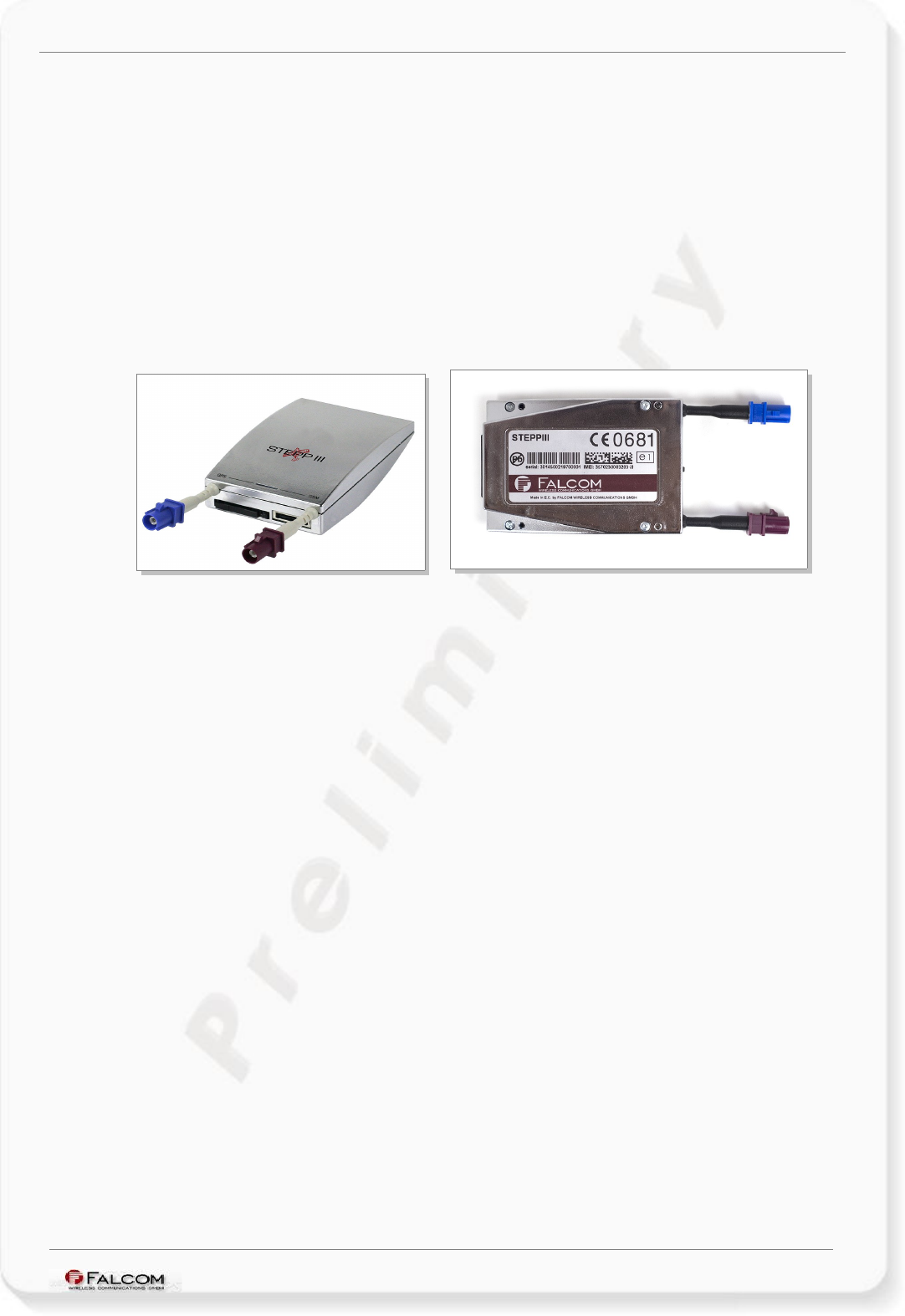
STEPPIII Hardware description Version 1.0.0
STEPPIII provides Geofence features for territory management, route
verification, prohibited locations, parking area and more with exception
reporting to a wide variety of events, such as arrivals, departures, deliveries,
pick-ups, illegal entries, unauthorized movement, etc. STEPPIII contains a
data-logger that enables it to archive unique locations in sequence for up to
45 days for later analysis and evaluation (for example, archive interval up to
20 sec.).
The physical interface to the terminal application is made through integrated
connectors. These are required for controlling the terminal, receiving GPS
location data, transferring data and providing power supply lines. STEPPIII
provides 2 serial interfaces giving you maximum flexibility for local use.
Figure 1 shows the front and backside of the STEPPIII.
a) front side b) back side
Figure 1: Front and back side of STEPPIII
STEPPIII terminal can be implemented into any asset platform, including:
-Trailers
-Trucks
-Delivery vans
-Rail cars
-as well as other industrial monitoring installations.
and it can be used in a variety of applications, including:
•Fleet management
•Vehicle management
•Remote tracking and monitoring
•Safety and security
•Off-road applications
•Real-time Navigation and Positioning
•Finding streets and routes
•Travel planning and many others …
The STEPPIII - EVALKIT provides an easy and efficient way to evaluate and
configure all system parameters of the mobile client. The configuration of the
STEPPIII can be done via local serial link or remotely via the GSM network. The
STEPPIII concept reduces the efforts for the creation of a turn key tracking
and security solution to the definition of the server (dispatcher) application.
In this way the time-to-market, the design-in risk and the total cost of solution
are substantially reduced.
This confidential document is a property of FALCOM and may not be copied or circulated without previous permission.
Page 7
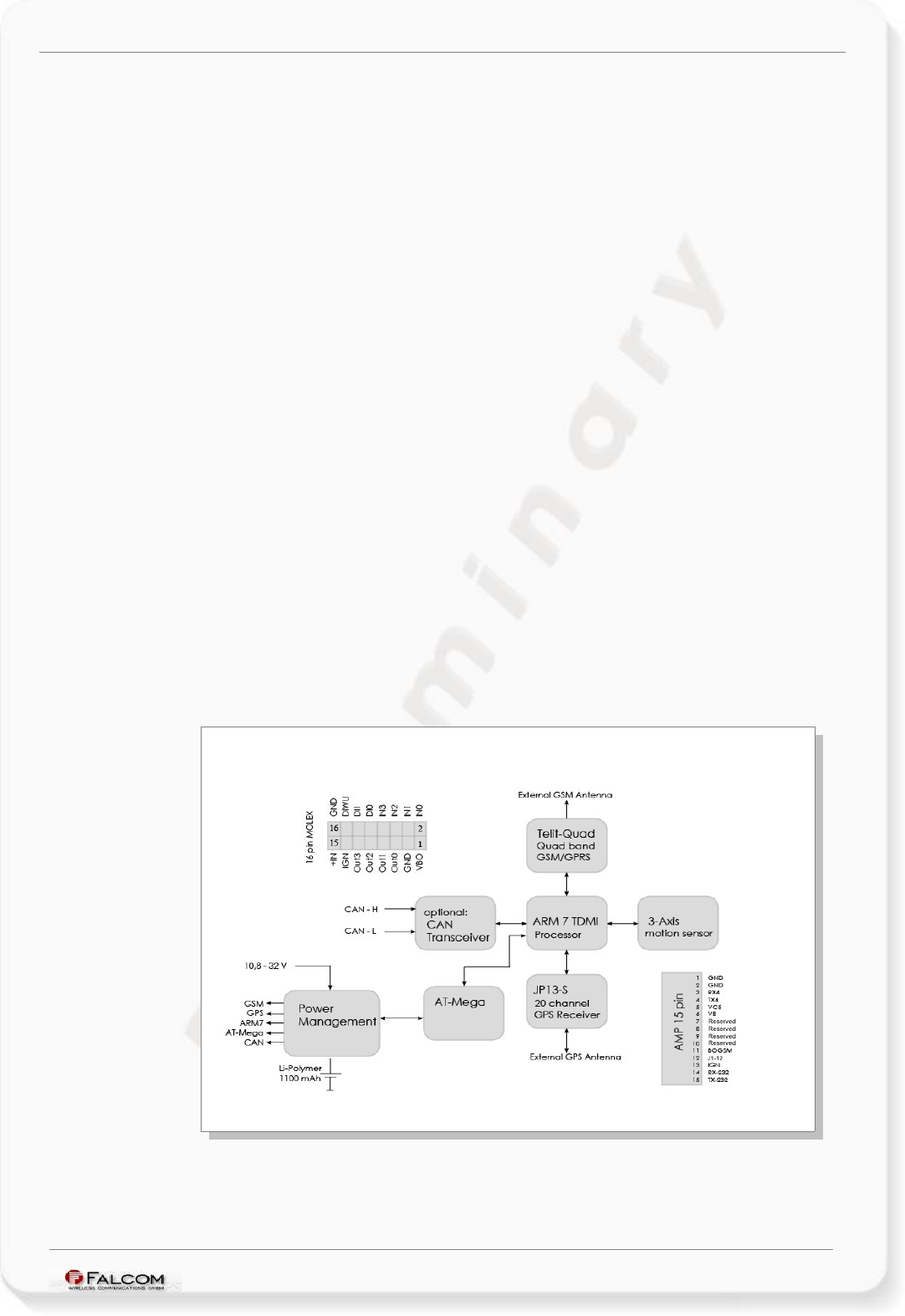
STEPPIII Hardware description Version 1.0.0
1.2 Circuit concept
The STEPPIII architecture includes the following major functional components
(see figure 2):
Architecture integrates:
High-performance Quad-Band GSM/GPRS core
High sensitivity 20 parallel channel SiRFStarIII
ARM7TDMI processor that controls all functions of the system
Rechargeable 1100 mA Li-Polymer battery
CAN bus (optional)
3D motion detection
Interface circuitry
Physical interfaces:
Molex connector (Type: Molex 43045-1609, and counterpart:
Casing: 43025-1600 and Box type spring contact: 43031-0001) for
power supply and I/O’s (16-pin connector)
AMP connector (Type: AMP5-558556-1, and counterpart: 558666-
1) for serial interfaces (15-pin connector)
SIM Card reader (Type: Molex-91228-0002 small SIM Card)
GSM antenna interface (Type: Connector 50
Ω
Fakra/Radiall SMB-
male)
GPS antenna interface (Type: Connector 50
Ω
Fakra/Radiall SMB-
male)
LED
Figure 2: Architecture of the STEPPIII terminal
This confidential document is a property of FALCOM and may not be copied or circulated without previous permission.
Page 8

STEPPIII Hardware description Version 1.0.0
1.3 Used abbreviations
Abbreviation Description
ASIC Application Specific Integrated Circuit
DOP Dilution of Precision
GPS Global Positioning System
GSM Global Standard for Mobile Communications
GGA GPS Fixed Data
HDOP Horizontal DOP
HW Hardware
IMEI International Mobile Equipment Identity
I/O Input/Output
NMEA National Marine Electronics Association
PRN Pseudorandom Noise Number – The Identity of GPS satellites
RF Radio Frequency
RTC Real Time Clock
RXQUAL Received Signal Quality
SIM Subscriber Identification Module
SMS Short Message Service
SRAM Static Random Access Memory
TA Terminal Adapter
TE Terminal Equipment
TP Transmit Protocol
TTFF Time to First Fix
SA Selective Availability
WAAS Wide Area Augmentation System
MSK Minimum Shift Keying
Table 1: Used abbreviations
1.4 Related documents
1. ETSI GSM 07.05:“Use of Data Terminal Equipment–Data Circuit terminating
Equipment interface for Short Message Service and Cell Broadcast
Service”
2. ETSI GSM 07.07“AT command set for GSM Mobile Equipment”
3. ITU-T V.25ter “Serial asynchronous automatic dialing and control”
4. SiRF binary and NMEA protocol specification;
www.falcom.de/Service/Manuals/SiRF
5. steppIII_firmware_2.5.xx_manual.pdf (supporting GSM & GPRS services)
6. Application_notes_on_vehicle_mounting.pdf
7. AppNotes_connecting_a_bar_code_scanner_to a_STEPPIII.pdf
This confidential document is a property of FALCOM and may not be copied or circulated without previous permission.
Page 9

STEPPIII Hardware description Version 1.0.0
2 SECURITY
IMPORTANT FOR THE EFFICIENT AND SAFE OPERATION OF YOUR GSM-MODEM,
READ THIS INFORMATION BEFORE USE!
Your cellular engine STEPPIII is one of the most exciting and innovative
electronic products ever developed. With it you can stay in contact with
your office, your home, emergency services and others, wherever service is
provided.
This chapter contains important information for the safe and reliable use of
the STEPPIII. Please read this chapter carefully before starting to use the
cellular engine STEPPIII.
2.1 General information
Your STEPPIII device utilizes the GSM/GPRS/GPS standard for cellular
technology. GSM/GPRS is a newer radio frequency („RF“) technology than
the current FM technology that has been used for radio communications for
decades. The GSM standard has been established for use in the European
community and elsewhere. Your modem is actually a low power radio
transmitter and receiver. It sends out and receives radio frequency energy.
When you use your modem, the cellular system handling your calls controls
both the radio frequency and the power level of your cellular modem.
For the use of the acquired devices SIM cards are needed, which are not
included in the scope of delivery of the device. The SIM cards can be
acquired e.g. by specific providers. From the use of the SIM cards can result
additional costs, which are to be borne by the purchaser (client) of the
devices. The seller does not cover the extra costs for the use of the devices.
The seller gives no recommendation for the use of specific SIM cards and
does not liable also for the fact that the devices are usable with all available
SIM cards. The seller also covers no other costs, that are needed for the
application of the customer in connection with this device.
2.2 Exposure to RF energy
There has been some public concern about possible health effects of using a
GSM modem. Although research on health effects from RF energy has
focused for many years on the current RF technology, scientists have begun
research regarding newer radio technologies, such as GSM. After existing
research had been reviewed, and after compliance to all applicable safety
standards had been tested, it has been concluded that the product is fit for
use.
If you are concerned about exposure to RF energy there are things you can
do to minimize exposure. Obviously, limiting the duration of your calls will
reduce your exposure to RF energy. In addition, you can reduce RF exposure
by operating your cellular modem efficiently by following the guidelines
below.
This confidential document is a property of FALCOM and may not be copied or circulated without previous permission.
Page 10

STEPPIII Hardware description Version 1.0.0
2.3 Efficient modem operation
In order to operate your modem at the lowest power level, consistent with
satisfactory call quality please take note of the following hints.
If your modem has an extendible antenna, extend it fully. Some models allow
you to place a call with the antenna retracted. However, your modem
operates more efficiently with the antenna fully extended.
Do not hold the antenna when the modem is „IN USE“. Holding the antenna
affects call quality and may cause the modem to operate at a higher power
level than needed.
2.4 Antenna care and replacement
Do not use the modem with a damaged antenna. If a damaged antenna
comes into contact with the skin, a minor burn may result. Replace a
damaged antenna immediately. Consult your manual to see if you may
change the antenna yourself. If so, use only a manufacturer-approved
antenna. Otherwise, have your antenna repaired by a qualified technician.
Use only the supplied or approved antenna. Unauthorized antennas,
modifications or attachments could damage the modem and may
contravene local RF emission regulations or invalidate type approval.
2.5 Driving
Check the laws and regulations on the use of cellular devices in the area
where you drive. Always obey them. Also, when using your modem while
driving, please pay full attention to driving, pull off the road and park before
making or answering a call if driving conditions so require. When applications
are prepared for mobile use they should fulfill road-safety instructions of the
current law!
2.6 Electronic devices
Most electronic equipment, for example in hospitals and motor vehicles is
shielded from RF energy. However, RF energy may affect some
malfunctioning or improperly shielded electronic equipment.
2.7 Vehicle electronic equipment
Check your vehicle manufacturer’s representative to determine if any on
board electronic equipment is adequately shielded from RF energy.
2.8 Medical electronic equipment
Consult the manufacturer of any personal medical devices (such as
pacemakers, hearing aids, etc.) to determine if they are adequately
shielded from external RF energy.
Turn your STEPPIII device OFF in health care facilities when any regulations
posted in the area instruct you to do so. Hospitals or health care facilities
may be using RF monitoring equipment.
This confidential document is a property of FALCOM and may not be copied or circulated without previous permission.
Page 11

STEPPIII Hardware description Version 1.0.0
2.9 Aircraft
Turn your STEPPIII OFF before boarding any aircraft.
Use it on the ground only with crew permission.
Do not use it in the air.
To prevent possible interference with aircraft systems, Federal Aviation
Administration (FAA) regulations require you to have permission from a crew
member to use your modem while the plane is on the ground. To prevent
interference with cellular systems, local RF regulations prohibit using your
modem whilst airborne.
2.10 Children
Do not allow children to play with your STEPPIII device. It is not a toy. Children
could hurt themselves or others (by poking themselves or others in the eye
with the antenna, for example). Children could damage the modem or
make calls that increase your modem bills.
2.11 Blasting areas
To avoid interfering with blasting operations, turn your unit OFF when in a
“blasting area” or in areas posted: „turn off two-way radio“. Construction
crew often use remote control RF devices to set off explosives.
2.12 Potentially explosive atmospheres
Turn your STEPPIII device OFF when in any area with a potentially explosive
atmosphere. It is rare, but your modem or its accessories could generate
sparks. Sparks in such areas could cause an explosion or fire resulting in
bodily injury or even death.
Areas with a potentially explosive atmosphere are often, but not always,
clearly marked. They include fuelling areas such as petrol stations; below
decks on boats; fuel or chemical transfer or storage facilities; and areas
where the air contains chemicals or particles, such as grain, dust or metal
powders.
Do not transport or store flammable gas, liquid or explosives, in the
compartment of your vehicle, which contains your modem or accessories.
Before using your modem in a vehicle powered by liquefied petroleum gas
(such as propane or butane) ensure that the vehicle complies with the
relevant fire and safety regulations of the country in which the vehicle is to
be used.
2.13 Non-ionizing radiation
As with other mobile radio transmitting equipment users are advised that for
satisfactory operation and for the safety of personnel, it is recommended
that no part of the human body is allowed to come too close to the antenna
during operation of the equipment.
This confidential document is a property of FALCOM and may not be copied or circulated without previous permission.
Page 12

STEPPIII Hardware description Version 1.0.0
The radio equipment shall be connected to the antenna via a non-radiating
50 Ohm coaxial cable.
The antenna shall be mounted in such a position that no part of the human
body will normally rest close to any part of the antenna. It is also
recommended to use the equipment not close to medical devices as for
example hearing aids and pacemakers.
This confidential document is a property of FALCOM and may not be copied or circulated without previous permission.
Page 13

STEPPIII Hardware description Version 1.0.0
3 SAFETY STANDARDS
This GSM/GPS modem complies with all applicable RF safety standards.
The embedded GSM/GPRS/GPS modem meets the safety standards for RF
receivers and the standards and recommendations for the protection of
public exposure to RF electromagnetic energy established by government
bodies and professional organizations, such as directives of the European
Community, Directorate General V in matters of radio frequency
electromagnetic energy.
This confidential document is a property of FALCOM and may not be copied or circulated without previous permission.
Page 14

STEPPIII Hardware description Version 1.0.0
4 TECHNICAL DATA
4.1 General specifications of terminal STEPPIII
Power supply:
✔Supply voltage from +10.8 V to +32.0 V (absolute
maximum ratings) suitable for direct connection to
an automotive +12V or +24V DC supply.
Power saving:
✔Sleep modes minimize power consumption to 3 …
15 mA. For more details refer to the chapter on
page.
Battery:
✔Built-in a rechargeable Li-Polymer battery with a
capacity of 1100 mA/h.
Temperature:
✔Normal operation: -30 °C to + 80 °C (see chapter
4.1.3 for further details)
Evaluation kit:
✔The STEPPIII EvalBoard is designed to test, evaluate
and make basis configuration to enable remote
monitoring/configuration of the FALCOM STEPPIII. It
provides a sample configuration for application.
Physical characteristics:
✔Size: 55.0 ± 0.15 mm x 80.0 ± 0.15 mm x 25.0 ± 0.15
mm
✔Weight: ca. 90 g
I/O interface:
✔2 x digital inputs (hardware predefined)
✔2 x digital inputs (hardware predefined as Ignition-
pins)
✔1 x digital inputs (hardware predefined as Wakeup
pin)
✔4 x analog/digital inputs (controlled by firmware as
digital or analog inputs)
✔4 x digital outputs (hardware predefined)
✔1 x power supply output
Sleep ON/OFF functions:
✔4 x Sleep modes - programmable with PFAL
commands.
This confidential document is a property of FALCOM and may not be copied or circulated without previous permission.
Page 15

STEPPIII Hardware description Version 1.0.0
Firmware:
✔User customisable
Upgradeable:
✔STEPPIII firmware upgradeable via serial interface
and over air GPRS network.
Sensor:
✔3D motion sensor
Memory:
✔2 MByte FLASH for configuration, data-logging
and firmware storage
Serial ports:
✔2 x full duplex serial communication (Serial Port 0
and Serial Port 1)
Serial Interface Setting:
✔F ull duplex serial communication, CMOS level
✔4-wire (2 x Rx and 2 x Tx) serial communication
✔Baud rate on the serial ports (user selectable):
✔8 data bits, no parity, 1 stop bit, no hardware
Casing:
✔Fully shield
This confidential document is a property of FALCOM and may not be copied or circulated without previous permission.
Page 16

STEPPIII Hardware description Version 1.0.0
4.1.1 Backup Battery Technical Data (1100 mA/h)
Electrical characteristics:
Nominal voltage (V) 3.70
Typical capacity 20°C (mA/h) 1100 mA/h @ 4.2 V
Operating conditions:
Charging method Constant Current/
Constant Voltage
Charging voltage 4.2 VDC
Charging current 470 mA
Charging temperature range 0°C to + 40°C
Discharge current 1C max. continuous
Discharge temperature range -20°C to +60°C
4.1.2 Power consumption
To be defined.
4.1.3 Operating temperatures
Parameter Min Typ Max Unit
Ambient temperature (according to GSM 11.10) -40 25 +85 °C
Operating temperature (internal battery disabled) *-30 °C 25 +80 °C
Charging temperature (internal battery enabled) 0 °C 25 +40 °C
Discharging temperature (internal battery enabled) 20 °C 25 +60 °C
* These temperatures can affect the sensitivity and performance of the GSM engine.
Table 2: Operating temperature
This confidential document is a property of FALCOM and may not be copied or circulated without previous permission.
Page 17

STEPPIII Hardware description Version 1.0.0
4.2 Technical specifications of GSM/GPRS engine
Frequency bands:
✔Quad band: EGSM 900, EGSM 850,GSM 1800, GSM
1900
✔Compliant to GSM Phase 2/2+
GSM class:
✔Small MS
Transmit power:
✔Class 4 (2 W) at EGSM900 and GSM850
✔Class 1 (1 W) at GSM1800 and GSM 1900
GPRS connectivity:
✔GPRS multi-slot class 10
✔GPRS mobile station class B
DATA:
GPRS
⇒
✔GPRS data downlink transfer: max. 85.6 kbps (see
table 3).
✔GPRS data uplink transfer: max. 42.8 kbps (see
table 3).
CSD
⇒
✔CSD transmission rates: 2.4, 4.8, 9.6, 14.4 kbps, non-
transparent, V.110.
SMS:
✔Text mode
SIM interface:
✔Support SIM card: 3 V
GSM Antenna:
✔External GPS antenna connector.
Real time clock:
✔Implemented
Coding scheme 1 Timeslot 2 Timeslots 4 Timeslots
CS-1: 9.05 kbps 18.1 kbps 36.2 kbps
CS-2: 13.4 kbps 26.8 kbps 53.6 kbps
CS-3: 15.6 kbps 31.2 kbps 62.4 kbps
CS-4: 21.4 kbps 42.8 kbps 85.6 kbps
Table 3: Coding schemes and maximum net data rates over air interface
Please note that the values listed above are the maximum ratings which, in
practice, are influenced by a great variety of factors, primarily, for example,
traffic variations and network coverage.
This confidential document is a property of FALCOM and may not be copied or circulated without previous permission.
Page 18

STEPPIII Hardware description Version 1.0.0
4.3 Technical specifications of GPS receiver
GPS features:
✔OEM single board high sensitive 20 channel GPS
receiver, L1 1575.42 MHz, C/A code 1,023 MHz
chip rate.
✔GPS receiver with SiRFstarIII chip set
✔Processor type ARM7/TDMI
✔SiRF GSW3
Horizontal position accuracy:
✔Autonomous < 2.5 meters.
✔SBAS <2.0 meter
Datum:
✔WGS-84.
Sensitivity:
✔Autonomous acquisition -142 dBm
✔GSM /UMTS coarse time aided -155 dBm
✔CDMA precise time aided -155 dBm
✔Tracking -159 dBm
Time to First Fix (TTFF):
✔Hot start < 1 sec., average
✔Warm start < 35 sec., average
✔Cold start <35 sec, average
Dynamic Conditions:
✔Altitude 18,000 meters (60,000 feet) max.
✔Velocity < 515 meters/second (1000
knots) max.
✔Max. update rate 1 Hz
Supported protocols:
✔NMEA Msg.: GLL, GGA, RMC, VTG, GSV, GSA
✔Additional: IOP, GSM, AREA, BIN are also
supported by the software
developed by the FALCOM, see
related documents .
Crystal oscillator (TCXO):
✔Load sensitivity ± 10 % load change, 0.2 ± ppm
GPS antenna
✔External GPS antenna connector.
Memory
✔Combo-Memory (2 MB Flash–512 KB SRAM)
This confidential document is a property of FALCOM and may not be copied or circulated without previous permission.
Page 19

STEPPIII Hardware description Version 1.0.0
4.4 NMEA data message
The STEPPIII device delivers data in the NMEA-0183 format. Table 4 lists each
of the NMEA output messages supported by the STEPPIII terminal and a brief
description. For further description about NMEA, see Related documents[4].
Option Description
GGA Time, position and fix type data.
GLL Latitude, longitude, UTC time of position fix and status.
GSA GPS receiver operating mode, satellites used in the position solution and DOP values.
VTG The number of GPS satellites in view satellite ID numbers, elevation, azimuth and SNR values.
GSV The number of GPS satellites in view satellite ID numbers, elevation, azimuth and SNR values.
RMC Time, date, position, course and speed data.
Table 4: NMEA Output Messages
This confidential document is a property of FALCOM and may not be copied or circulated without previous permission.
Page 20

STEPPIII Hardware description Version 1.0.0
5 STEPPIII APPLICATION INTERFACE
5.1 Power supply
The power supply for the STEPPIII terminal has to be a single voltage source of
VVC+ = +10.8 V...+32.0 VDC. It must be able to provide sufficient current which
typically rises to 1.6 A. The operating voltage (VVC+ and GND) is protected
from reverse pole connection.
5.1.1 Power supply pins (15 and 16) on the MOLEX 16-pin connector
One VC+ pin on the MOLEX 16-pin connector is dedicated to connect the
supply voltage, 4 GND pins are recommended for grounding.
The VC+ and GND pins serve for charging the internal Li-Polymer battery and
powering the STEPPIII device. STEPPIII has automatic power ON-function
when external power is applied. The power supply for the STEPPIII is capable
of utilizing current ranging from VVC+ = +10.8 V ... +31.0 VDC designed for
automotive application.
Signal name I/O Parameter Description
VC+ I +10.8 V...+32.0 VDC. The
operating voltage must never be
exceeded.
Positive operating voltage. This line must be
protected against overcurrent (by a 2A fuse)
and protected against over-voltage.
GND - 0 V Ground (should be isolated from the vehicle
Grounds)
5.1.2 Automatic shutdown
Automatic shutdown takes effect if:
•the STEPPIII board is exceeding the critical limits of over or under
temperature.
•the battery is exceeding the critical limits of over or under
temperature.
•under voltage is detected.
The automatic shutdown procedure is equivalent to the power-down
initiated, i.e. STEPPIII logs off from the network and the software enters a
secure state avoiding loss of data.
5.2 Determining the External Equipment Type
Before you connect the serial port pins on the aforementioned terminals
(DCE units) to external equipment, you need to determine if the external
hardware serial ports are configured as DTE or DCE.
The FALCOM STEPPIII is designed for use as a DCE. Based on the
aforementioned conventions for DCE-DTE connections it communicates with
the customer application (DTE) using the following signals:
STEPPIII Terminal (DCE) to Application (DTE)
Rx <---------- TXD
Tx ----------> RXD
Table 5: The signalling definitions between DTE and DCE.
This confidential document is a property of FALCOM and may not be copied or circulated without previous permission.
Page 21
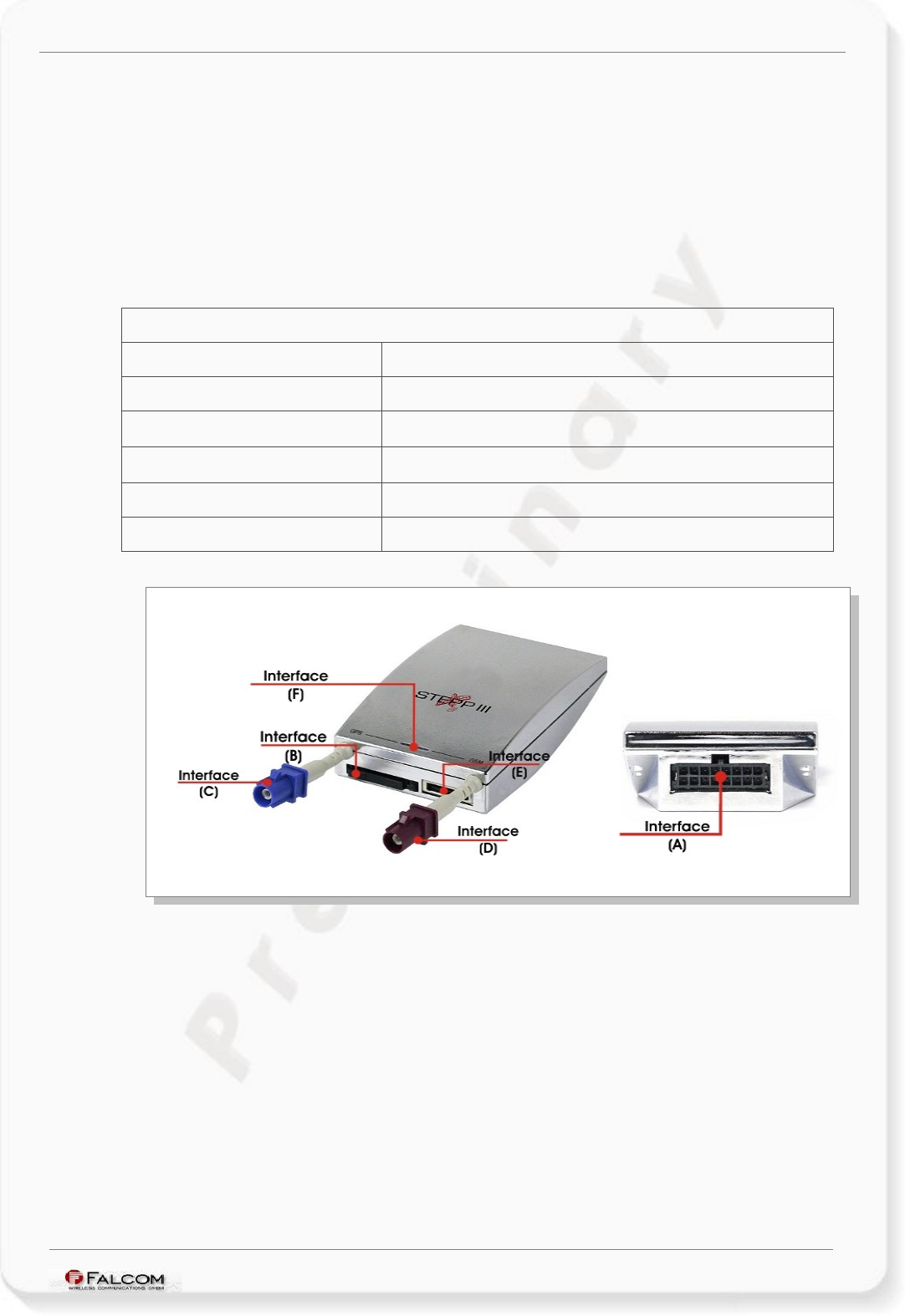
STEPPIII Hardware description Version 1.0.0
6 HARDWARE INTERFACES
This chapter describes the hardware interfaces:
•Molex 16-pin connector pinout
•AMP 15-pin connector pinout
•RF interfaces
•SIM interface
•LED’s indicator
Interface specifications
Interface A Molex 16-pin connector (43045-1609)
Interface B SIM card reader for small SIM cards (3V)
Interface C GPS RF Connector 50 Ω Fakra/Radiall (SMB-Male)
Interface D GSM RF Connector 50 Ω Fakra/Radiall (SMB-Male)
Interface E AMP 15-pin connector (5-558556-1)
Interface F Optical LED indicators. Free programmable.
Table 6: Interface specifications
Figure 3: Interface specifications
This confidential document is a property of FALCOM and may not be copied or circulated without previous permission.
Page 22

STEPPIII Hardware description Version 1.0.0
6.1 Interface A (16-pin Molex 43045-1609)
Figure 4: View of the 16-pin Molex 43045-1609 connector pin assignments
6.1.1 MOLEX connector pinout
PIN NAME I/O DISCRIPTION LEVEL
1 VBO Do not connect. Leave disconnected. -
2 IN0 I
Individually configurable as digital or analog input in
software.
The default configuration of this pin is an analog input.
As analog : Up to 32 V DC/10 bits resolution
As input: +10.8 ... +32 V DC (VIN ≤ VC+)
3 GND - Negative operating voltage (ground). 0 V
4 IN1 I
Individually configurable as digital or analog input in
software.
The default configuration of this pin is an analog input.
As analog : Up to 32 V DC/10 bits resolution
As input: +10.8 ... +32 V DC (VIN ≤ VC+);
5 OUT0 O Open collector output. 100 mA max. @ +10.8 .. +32V DC
6 IN2 I
Individually configurable as digital or analog input in
software.
The default configuration of this pin is a digital input.
As analog : Up to 32 V DC/10 bits resolution
As input: +10.8 ... +32 V DC (VIN ≤ VC+)
7 OUT1 O Open collector output. 100 mA max. @ +10.8 .. +32V DC
8 IN3 I
Individually configurable as digital or analog input in
software.
The default configuration of this pin is a digital input.
As analog : Up to 32 V DC/10 bits resolution
As input: +10.8 ... +32 V DC (VIN ≤ VC+)
9 OUT2 O Open collector output. 100 mA max. @ +10.8 .. +32V DC
10 DI0 I Currently as digital input only. CAN bus option. HIGH = programmable; LOW = programmable
11 OUT3 O Open collector output. 100 mA max. @ +10.8 .. +32V DC
12 DI1 I Currently as digital input only. CAN bus option. HIGH = programmable; LOW = programmable
13 IGN I General propose input. Connect it to the vehicle ignition. HIGH ≥+10.8 .. +32 V DC; LOW = 0V
14 AOO/
DiWu IThis pin can be used to put to sleep and wake up the
main microcontroller . HIGH = programmable; LOW = programmable
15 VCC I
Power supply input (Input 7). The power supply must be
able to meet the requirements of current consumption.
Care must be taken so that the operating voltage applied
to the terminal stay within the voltage range. Applying a
voltage outside of the voltage range can damage the
module.
VI = +10.8 ... +32.0 V
16 GND - Negative operating voltage (ground). 0 V
Table 8: Pin description of the Molex 16-pin connector
This confidential document is a property of FALCOM and may not be copied or circulated without previous permission.
Page 23
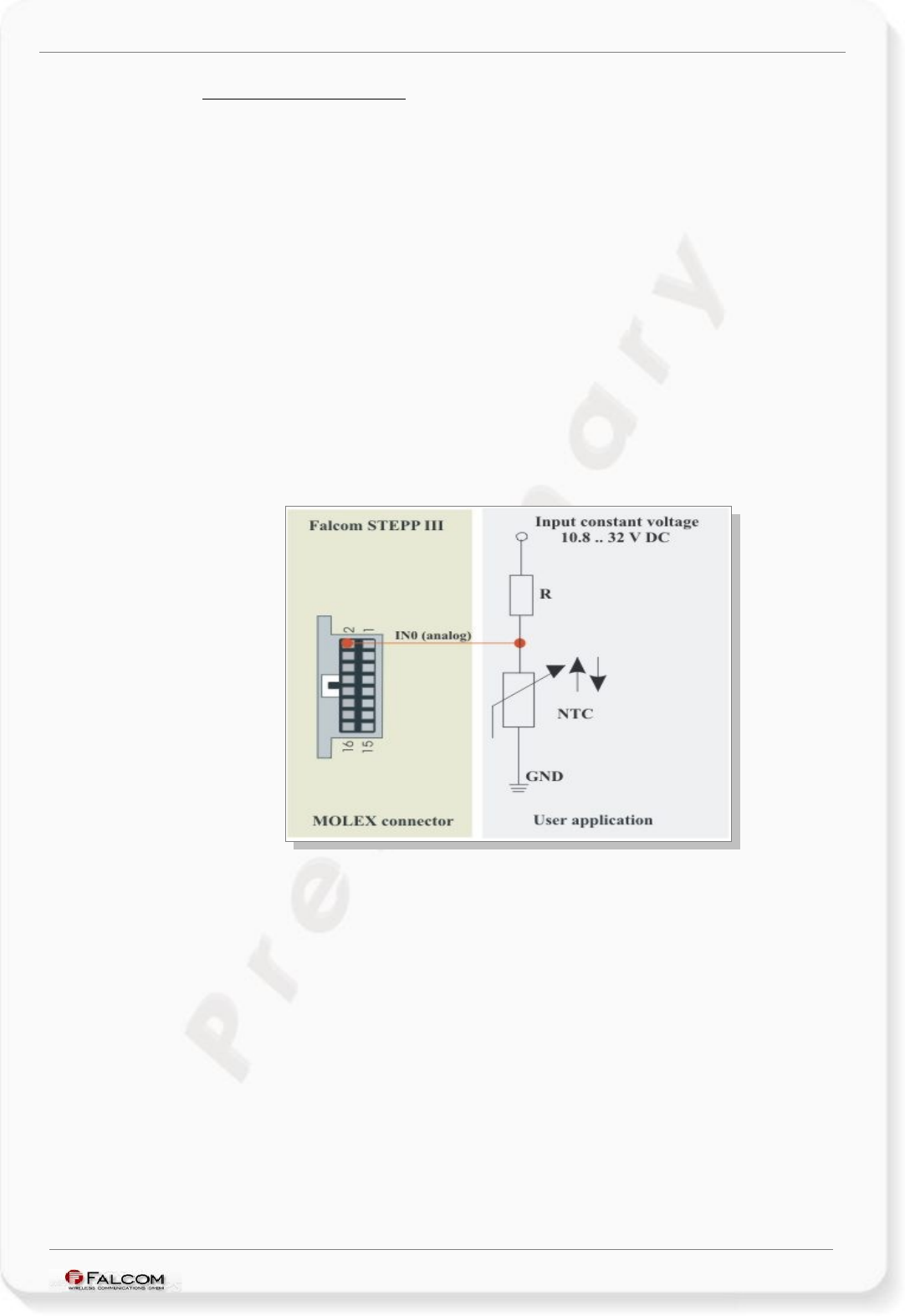
STEPPIII Hardware description Version 1.0.0
6.1.2 Special pin description
6.1.2.1 Analog inputs (2, 4, 6, 8)
Analog voltages up to 32 V with 10 bit resolution can be processed and
remotely evaluated by a server application. Pull-up resistor to a constant
input voltage allows for resistive transducers to ground, e.g. fuel sensor or
thermistors. Because the pins 2, 4, 6, and 8 can operate either as digital or
analog, they have to be configured and calibrated for such purposes
before using as analog outputs.
↓ Connection example for analog input 0 (IN0):
Thus, an analog input can be connected to a temperature sensor (a NTC
resistor for instance). It is possible to set a low temperature alarm and a high
temperature alarm (upper and lower values), passed to required
temperature. Passage through these thresholds will trigger an alarm. We
recommend to use SMS or TCP as alarm type with GPIOP as attachment
protocol. The SMS can be received on a mobile phone, modem or any GSM
device. An application example is shown in figure below:
Figure 5: Connection example for analog input (IN0)
↓ Connection example for analog input 1 (IN1):
Likewise, on another analog input you can install a tachometer generator.
The maximum output voltage of the tachometer is + 32 V (see illustrated
example in figure below).
Both circuit examples (the NTC diagram above and the Tachometer) are only illustrations to
show the aim of the analog inputs.
This confidential document is a property of FALCOM and may not be copied or circulated without previous permission.
Page 24
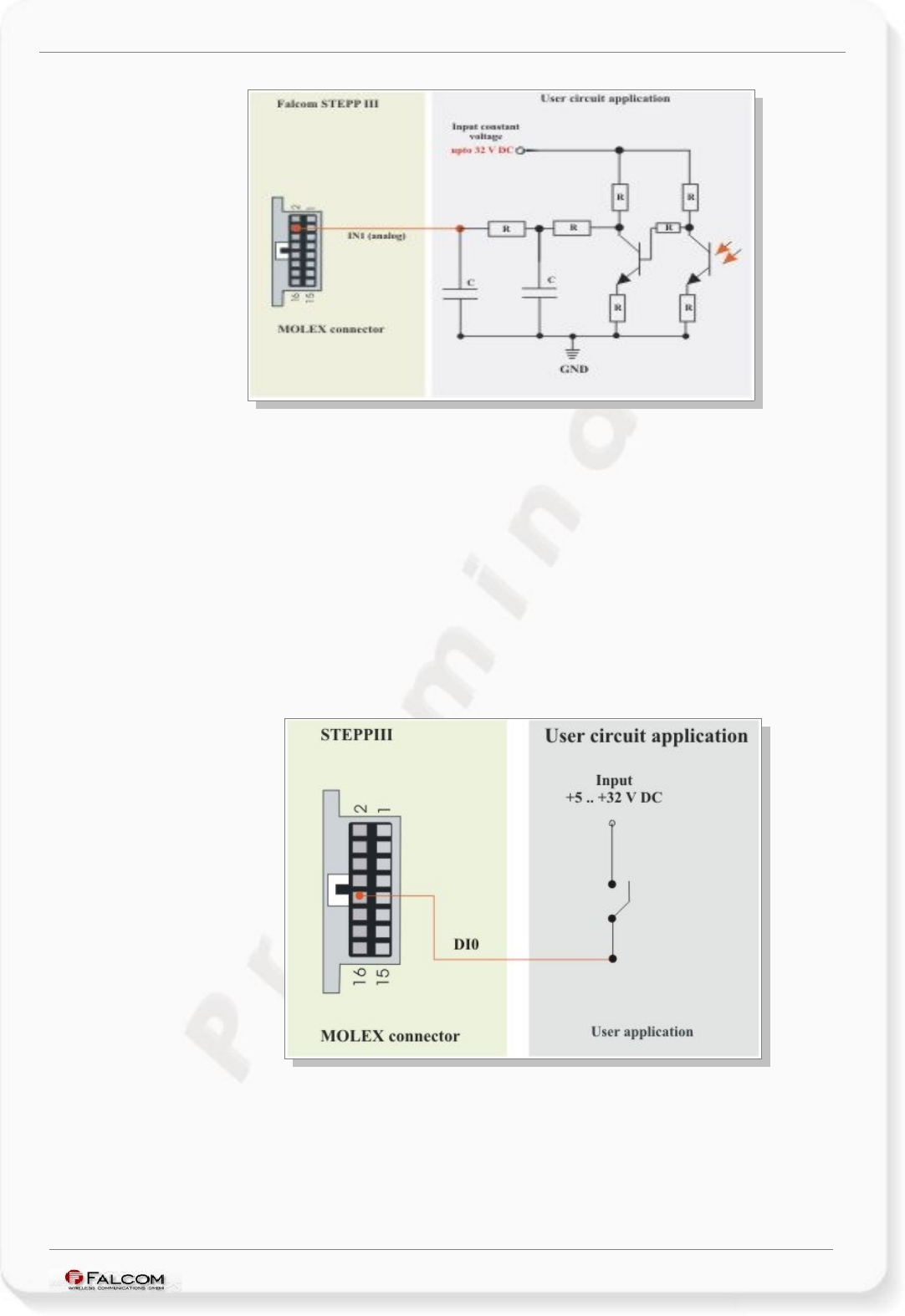
STEPPIII Hardware description Version 1.0.0
Figure 6: Connection example for analog input (IN1)
6.1.2.2 Digital Inputs (pin 10,12)
The inputs (pin 10, 12) on the MOLEX 16-pin connector are high active so
they can be connected to + 5 V ... 32 V DC. The figure below illustrates how
to connect these inputs. If one of the connected pins (inputs) is activated
(for at least 1 sec), STEPPIII will release an alarm (SMS or data connection).
The alarm type and the alarm text (alarm type SMS) depend on the software
configuration done by the user. The inputs can be configured by using the
Command Set manual. All inputs reserved for customer specific applications
can be connected as shown below:
Figure 7: Connection example for digital input (DI0)
A completed circuit example for all inputs is attached in section 10.1.1.
This confidential document is a property of FALCOM and may not be copied or circulated without previous permission.
Page 25
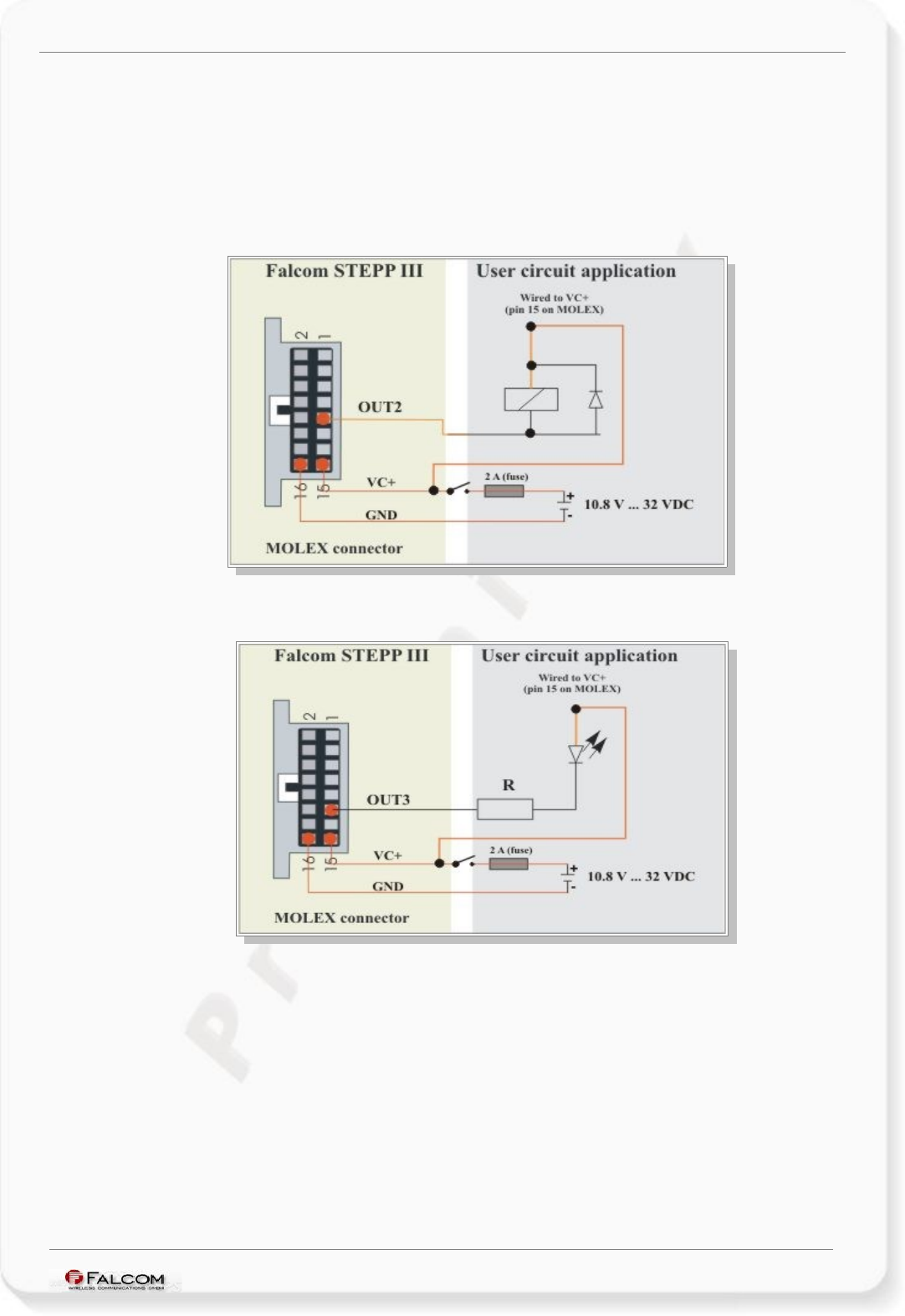
STEPPIII Hardware description Version 1.0.0
6.1.2.3 Outputs (pin 5, 7, 9, 11)
The STEPPIII supports four outputs. These can be set remotely by the server
application. The figures below show the schematic of possible output
connections. Each output can be directly connected to a LED, Relay etc.,
which needs no more than 100 mA. The figures below show the schematic of
possible output connections.
Figure 8: Connection example 1 for an output (Relay, OUT2)
Figure 9: Connection example 2 for an output (LED, OUT3)
This confidential document is a property of FALCOM and may not be copied or circulated without previous permission.
Page 26
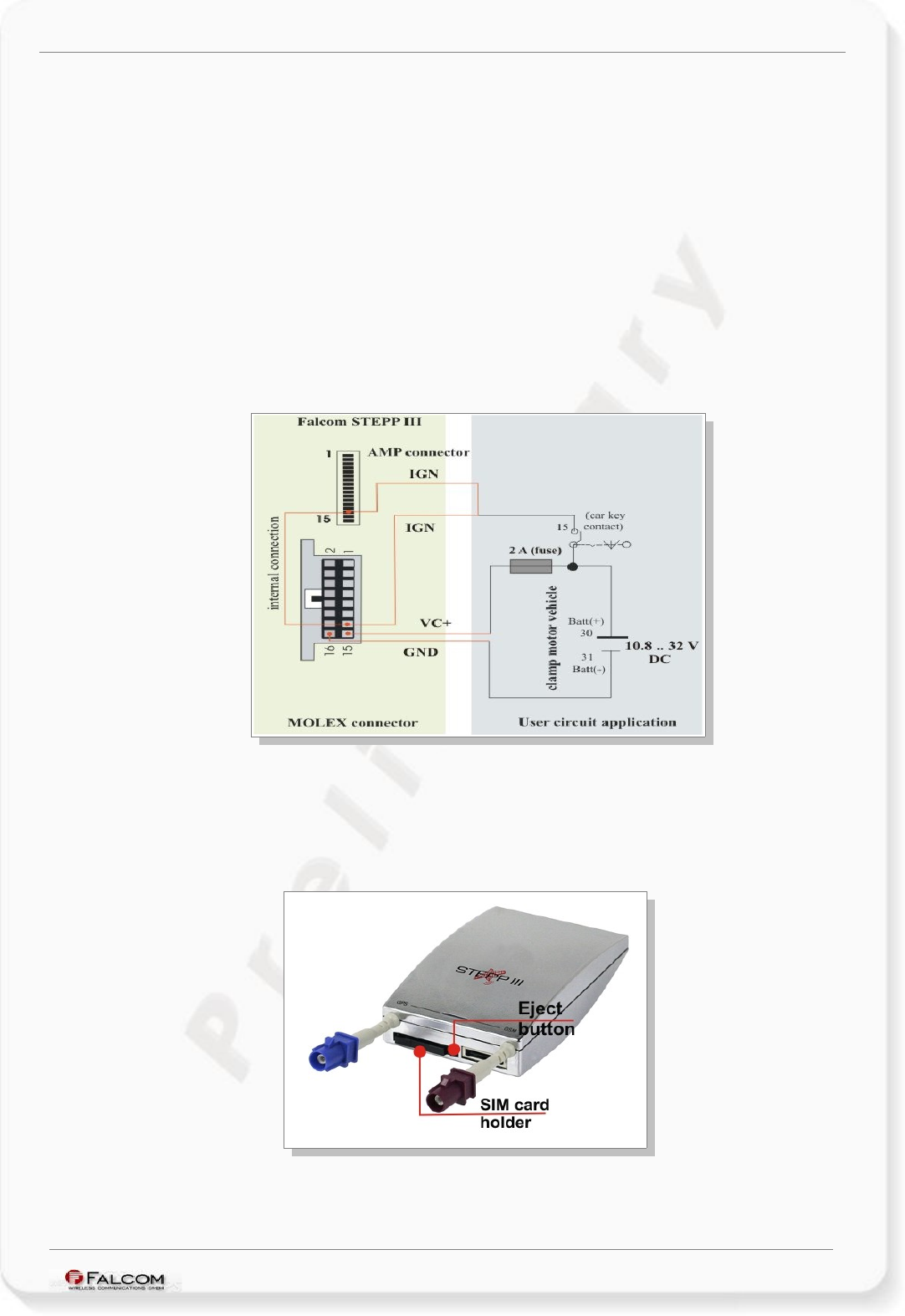
STEPPIII Hardware description Version 1.0.0
6.1.2.4 Ignition (pin 13)
STEPPIII provides two Ignition pins, one on the Molex connector (pin 13) and
one on the AMP connector (pin 13). Their functionality is the same. The
vehicle ignition line (starter lock clamp 15) can be connected to one of the
IGN pins of terminals (Pin 13). Thus, it is possible to send an alarm SMS (by
starting the car engine), prerequisite, the input IGN of the STEPPIII should be
configured for this purpose. Both pins 13 on the Molex connector and AMP
connector are internally connected with each other, so they can be
alternatively used. For more information see the corresponding figure in
chapter 10.1.1.
Note that, the IGN pins on the STEPPIII are not assumed to switch on the
STEPPIII terminal, they are only input pins, which can be used to control, for
example, the vehicle Ignition key.
Figure 10: Ignition connection example
6.2 Interface B (SIM card interface Molex-91228-0002)
The figure below shows the SIM card reader interface of the STEPPIII.
Figure 11: View of the SIM card interface
This confidential document is a property of FALCOM and may not be copied or circulated without previous permission.
Page 27
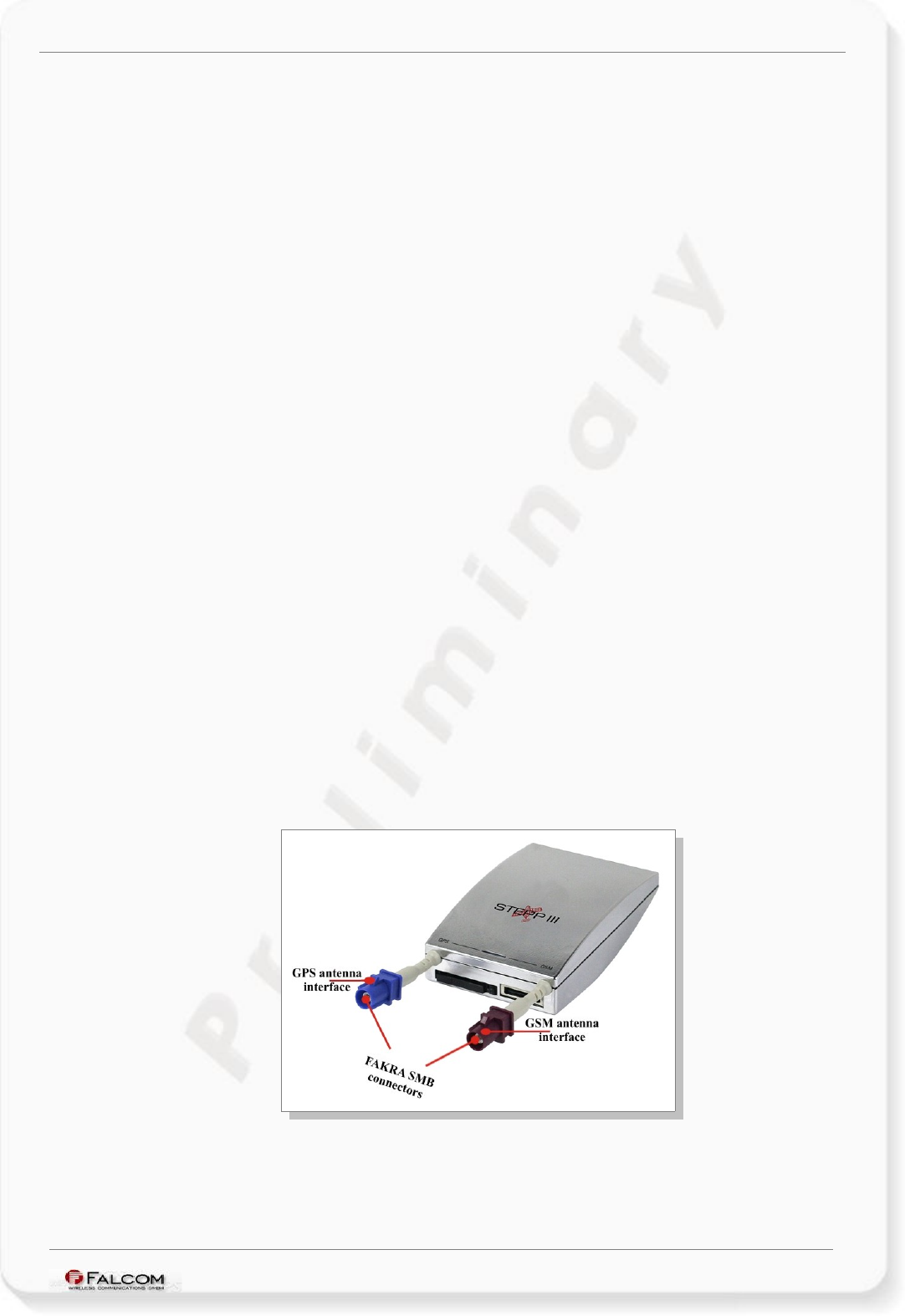
STEPPIII Hardware description Version 1.0.0
The SIM interface controls an internal small 3 V SIM card. This interface is fully
compliant with GSM 11.11 recommendations concerning SIM functions.
Note: The SIM should not be removed, while the module is powered
on. The SIM must only be removed when the STEPPIII is shut
down. To remove the SIM card press the Eject button (see
figure 11) then pull out the SIM card holder.
Note: The unit is not designed for use of single 5 V SIM cards. These
cards will generate an error which cannot be distinguished
from a faulty SIM card.
6.3 Interfaces C and D
The STEPPIII is fitted with two male SMB FAKRA connectors that accept a wide
variety of GSM/GPS antenna styles. One of them (right) (see figure below), is
provided for GSM RF connection. The GSM RF connector has an impedance
of 50 Ohm. A GSM antenna can be directly connected to this connector.
The other left-one is provided for GPS RF connection. The GPS RF connector
(see figure below) has an impedance of 50 Ohm. Active antennas have an
integrated low-noise amplifier. They can be directly connected to this
connector. The integrated low-noise amplifier of the antenna is internally
supplied with the specified voltage.
FALCOM GmbH provides a combined GSM/GPS antenna, especially, for the
STEPP devices, the GSM antenna operates on four frequencies: GSM 850/900
MHz and DCS 1800/1900 MHz. The GPS antenna operates on 1575.42 MHz
frequency. This antenna is suitable for mounting, covertly if required, in
various locations.
The order name of combined GSM/GPS antenna is: FAL-ANT-5
In order to operate properly the GPS part, it is recommended the GPS active
antenna should not exceed 25 mA. The antenna voltage is supplied
internally. The GPS antenna is protected from reverse pole connection.
The figure below shows the position of GSM/GPS connectors.
Figure 12: View of the GSM/GPS antenna cable.
Both GSM/GPS antenna cables with their FAKRA connectors are connected
to STEPPIII. Both GSM and GPS antenna cables have the same length.
This confidential document is a property of FALCOM and may not be copied or circulated without previous permission.
Page 28

STEPPIII Hardware description Version 1.0.0
6.4 Interface E (AMP 558556-1 Connector)
Figure 13: View of the 15-pin AMP5-558556-1 connector pin assignments
CAUTION INSERT THE 15-PIN AMP ADAPTER KINDLY INTO THE AMP SLOT OF TERMINAL.
FORCING THE ADAPTER MAY DAMAGE THE CONNECTOR PINS. IF YOU FEEL
ANY RESISTANCE WHILE INSERTING THE ADAPTER INTO THE AMP SLOT OF
TERMINAL, REMOVE IT IMMEDIATELY AND CHECK FOR ANY DAMAGE OF ITS
CONNECTOR OR BEND PINS.
6.4.1 AMP connector pinout
PIN NAME I/O DESCRIPTION LEVEL
1 GND - Negative operating voltage (grounds). 0 V
2 GND - Negative operating voltage (grounds). 0 V
3 RX4 I Second Serial interface (Receive data). Do not use for
firmware update V24, ±12 V
4 TX4 O Second Serial interface (Transmit data). Do not use for
firmware update V24, ±12 V
5 VC5 O Power output for external accessories. This pin delivers
either 5 V or 3.3 VDC. By default it delivers 5V.100 mA @ 3.3 VDC
6 VB O Power output for external accessories. This pin delivers
the same voltage level as internal battery. VOUT= 3.5V .. 4.2 VDC
7 - - Reserved -
8 - - Reserved -
9 - - Reserved -
10 - - Reserved -
11 BoGSM I Do not connect. Leave disconnected -
12 J1-12 - Do not connect. Leave disconnected -
13 IGN2 I
General propose input. Connect it to the vehicle
ignition. It is the same pin as pin 13 on MOLEX
connector.
HIGH ≥+10.8 .. +32 V DC; LOW = 0V
14 RxA
RS232 I
First Serial interface (receive data) for direct connection
to the host PC (configuration, evaluation, firmware) or to
the STEPPIII Eval-Board. If not used leave open.
V24, ±12 V
15 TxA
RS232 O
First Serial interface (transmit data) for direct
connection to the host PC (transmitting history data,
output GPS protocols and others) or to the STEPPIII
Eval-Board. If not used leave open.
V24, ±12 V
Table 9: Pins description of 15-pin AMP connector
This confidential document is a property of FALCOM and may not be copied or circulated without previous permission.
Page 29

STEPPIII Hardware description Version 1.0.0
6.4.2 Special pin description
6.4.2.1 VC 5
This output can be used to power some external accessories requiring up to
100 mA @ 5 VDC. Upon request, this pin can be equipped to deliver 3.3 VDC.
This power supply is available when the terminal is switched on.
6.4.2.2 Serial communication signals (RxA, TxA and Rx4, Tx4)
The board supports two full duplex serial channels. Both serial connections
are at V24, ±12 V level. You do not need to use any level shifter. The signals
on these pins are obtained to RS232 compatible signal levels. All supported
variable baud rates can be controlled from any terminal software. You can
directly communicate with a PC serial port. It is recommended to use the
STEPPIII Evalboard in order to communicate with the terminal.
First serial interface
RxA This is the main receiving channel and is used to
receive software commands to the board from any
terminal software (e.g. HyperTerminal) or from user
written software. Firmware update can be done only
through this serial port.
TxA This is the main transmitting channel and is used to
output navigation and measurement data to any
terminal software (e.g. HyperTerminal) or user written
software. Firmware update can be done only
through this serial port.
Second serial interface
Rx4 This is the second receiving channel and can also be
used to receive software commands to the board
from any terminal software (e.g. HyperTerminal) or
from user written software, but not firmware update.
Tx4 This is the main transmitting channel and is used to
output navigation and measurement data to any
terminal software (e.g. HyperTerminal) or user written
software, but not firmware update.
This confidential document is a property of FALCOM and may not be copied or circulated without previous permission.
Page 30
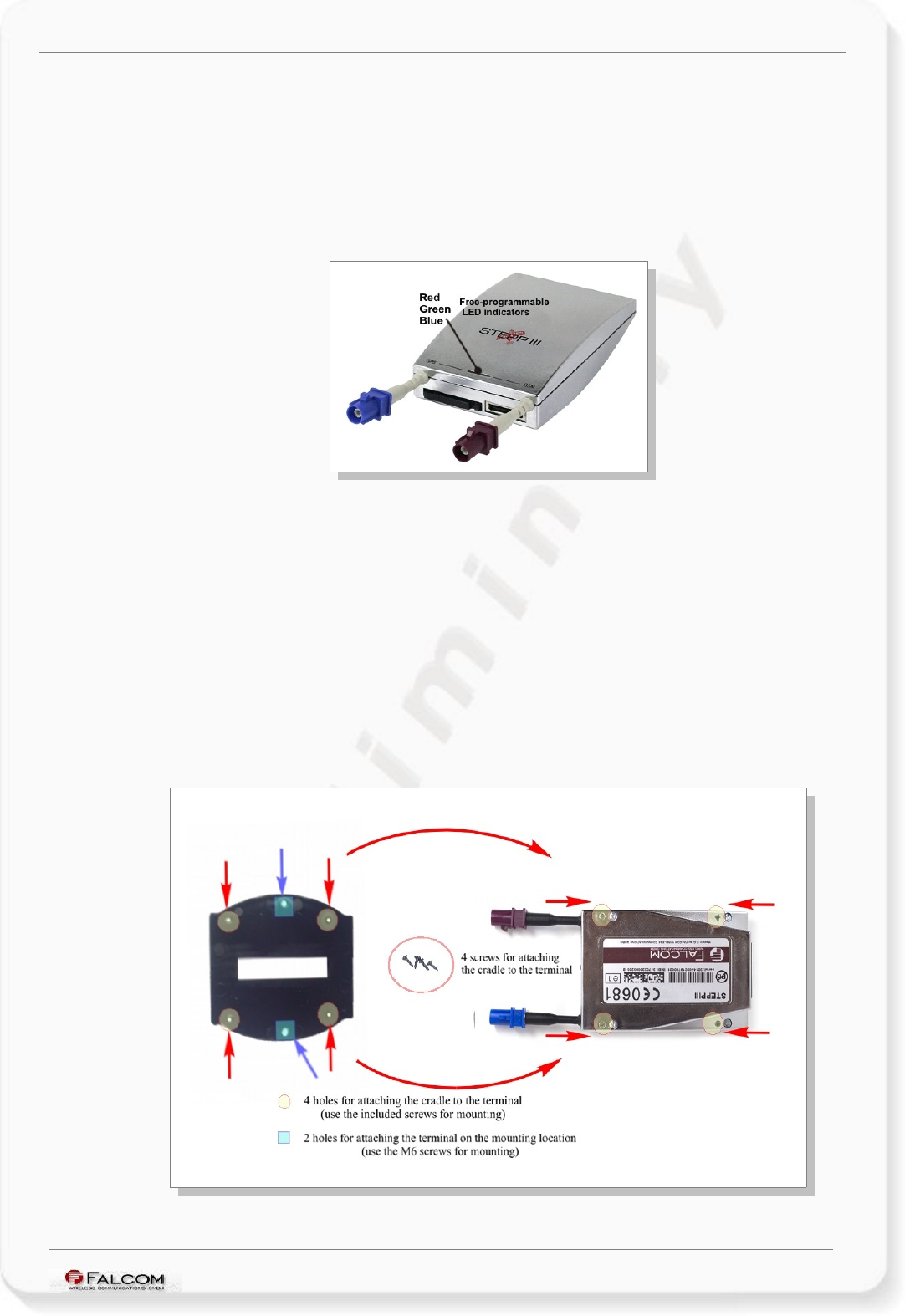
STEPPIII Hardware description Version 1.0.0
6.5 Interface F (LED’s description)
The actual state of the STEPPIII can be displayed by three LED’s on the
interface D of the terminal. These programmable and accessible LEDs can
be interfaced to build-in components to show their state. References, to
customize the device configuration, are available in the STEPPIII software
manual “STEPPIII_firmware_2.5.x_user_manual.pdf”.
Figure 14: View of the Red, Green, Blue LED indicators
6.6 Interface E (Mounting holes)
The STEPPIII compact terminal provides 4 holes for attaching it to the suitable
cradle. As a reference for mounting holes use figure 15 below in this section.
The cradle is available in the sales package. For detailed information about
mounting, please, refer to the related documents [1.4].
In order to avoid any damage during mounting of the terminal is required to
use (choose if the screws are damaged) properly the screws delivered with
STEPPIII. Fasteners are 22 x 6 mm screws plus suitable washers, or customized
screws.
Figure 15: View of the mounting holes
This confidential document is a property of FALCOM and may not be copied or circulated without previous permission.
Page 31
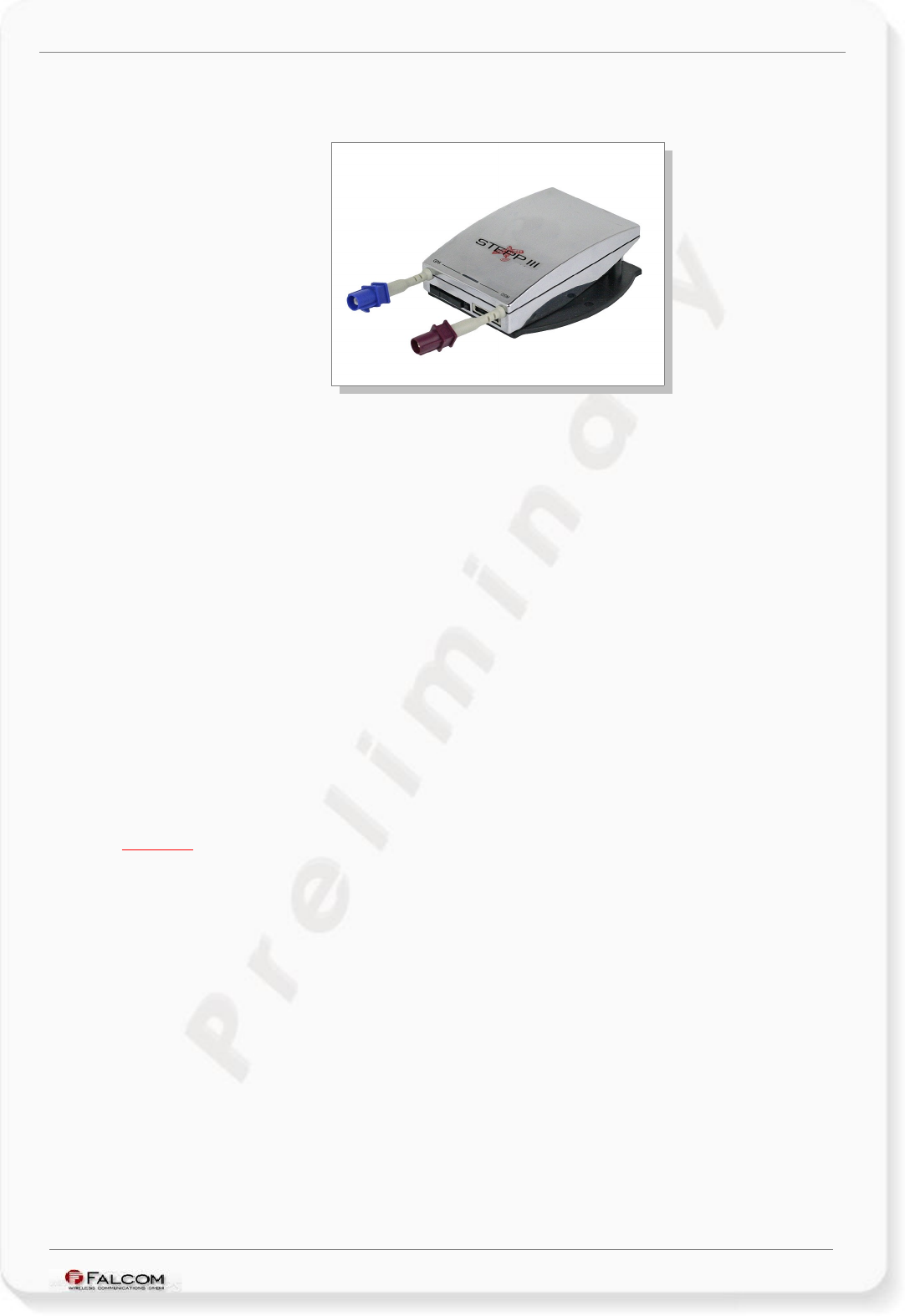
STEPPIII Hardware description Version 1.0.0
6.6.1.1 Mounting the cradle to the terminal
Figure 16: Attached cradle to the terminal.
In order to avoid any damage during mounting, place the terminal (if
needed) on the cradle and push it up/down until you see both terminal and
cradle holes are facing each other. Screws must be inserted with the screw
head on the bottom of cradle through to the provided holes on the bottom
of the STEPPIII. Use a suitable screwdriver to perform the rotation. Screw up
kindly the appropriate screws. To avoid short circuits ensure that the
customized screws (screws with different length) do not come into contact
with the STEPPIII PCB since there are a number of test points. Make sure that
the STEPPIII does not move up and down inside the cradle.
After you have secured up the cradle to the terminal, choose the mounting
location (see next section). The terminal can be mounted in different
locations on a wall or vehicle, metal or non-metal sheets. It depends on the
user’s application. As a reference for mounting holes use figure 15 (blue
colour).
6.6.1.2 Placing the terminal
CAUTION : IN ORDER TO COMPLY WITH RF EXPOSURE REQUIREMENTS, INSTALL THE
TERMINAL SO THAT A MINIMUM DISTANCE OF 20 CM CAN BE MAINTAINED
BETWEEN THE ANTENNA AND PERSONS. INSTALL THE EXTERNAL ANTENNA SO
THAT A MINIMUM DISTANCE OF 20 CM CAN BE MAINTAINED BETWEEN THE
ANTENNA AND PERSONS, WITH ANTENNA GAIN NOT EXCEEDING 3 DBI.
1. Place mounted terminal in a proper location:
2. The mounting location must be chosen far enough from electronic
devices so that no interference takes place. Please, contact your
vehicle supplier for more information.
3. Make sure the screws are suitable for mounting plate.
4. Drill appropriate screws (M6) the two indentations on the cradle.
5. Secure the cradle and terminal and firmly fixed on the selected
mounting place.
All radio-transmitting devices send signals, which may cause interference in
different electronic devices (PC, television or electronic devices etc). To
avoid interference, place the terminal far enough from other electronic
devices.
This confidential document is a property of FALCOM and may not be copied or circulated without previous permission.
Page 32
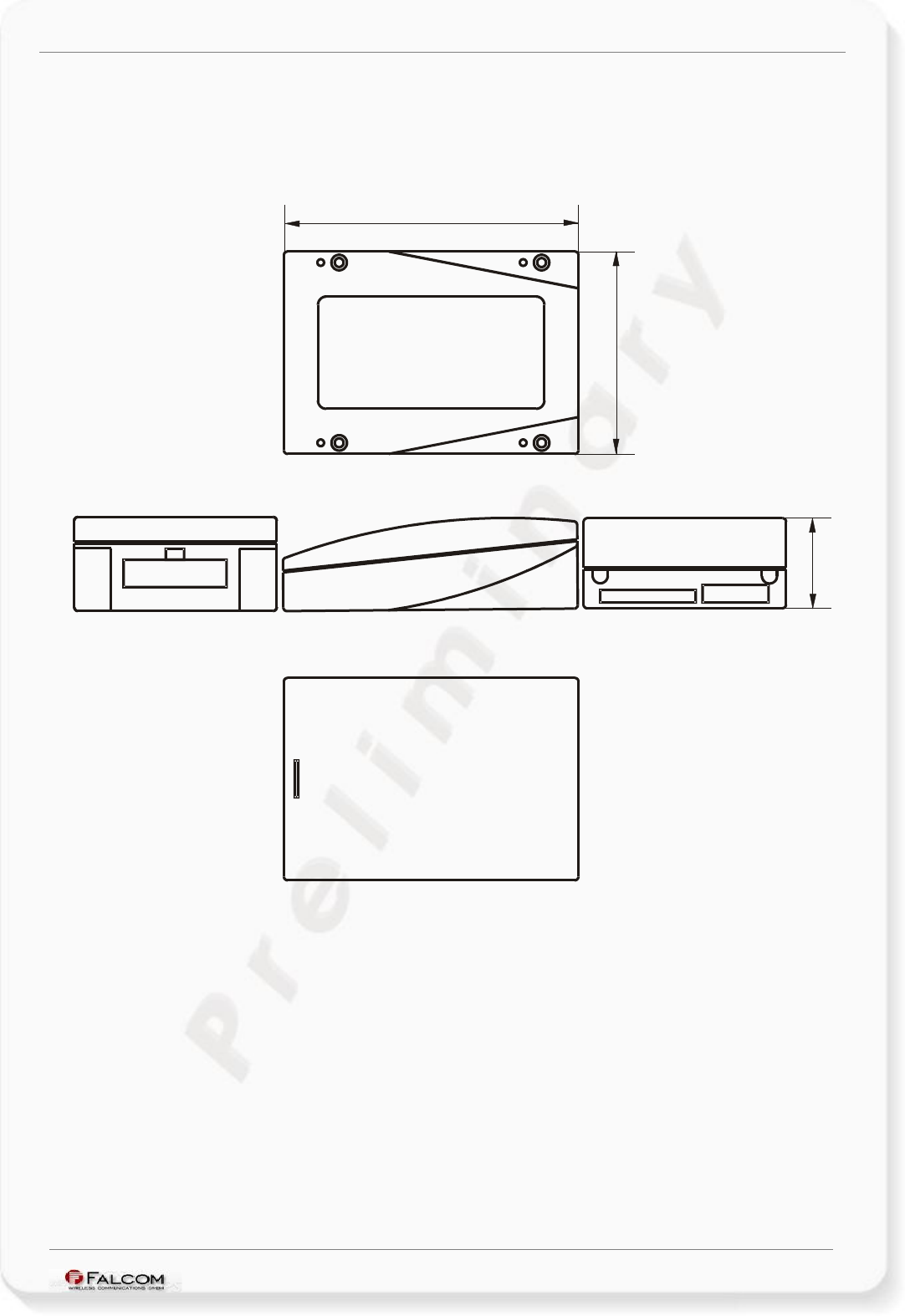
STEPPIII Hardware description Version 1.0.0
7 HOUSING
The housing material: Galvano-ABS, gloss-chromium-plated.
Figure 17: Housing of the STEPPIII.
This confidential document is a property of FALCOM and may not be copied or circulated without previous permission.
Page 33
55
25
80
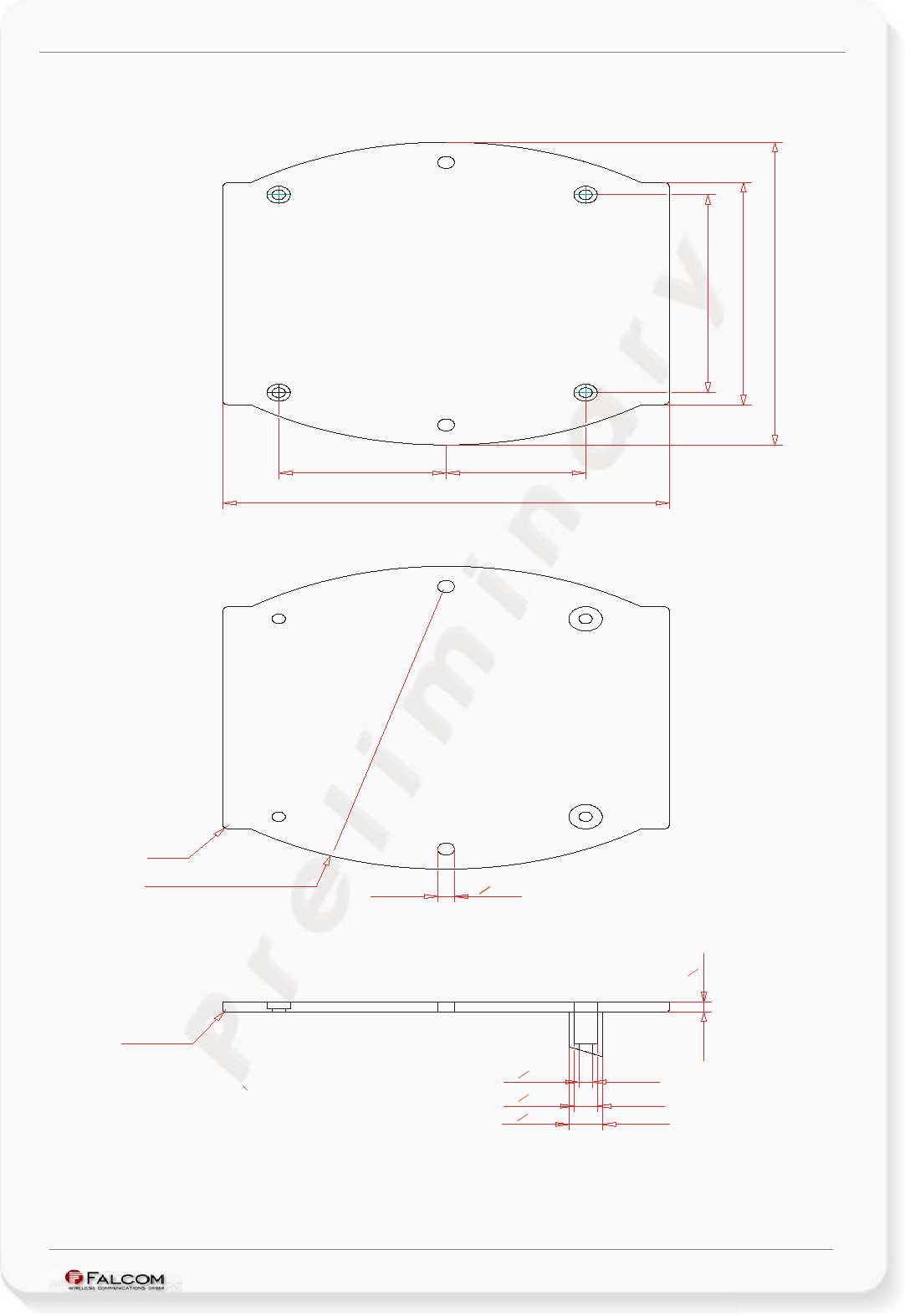
STEPPIII Hardware description Version 1.0.0
8 STEPPII-MOUNTING CRADLE
2530
80
49
55
75
O 2.5
O 3
O 2.4
O 4.2
O 6
R0.5
R1
R66.25
Figure 18: Mounting cradle of the STEPPII
This confidential document is a property of FALCOM and may not be copied or circulated without previous permission.
Page 34

STEPPIII Hardware description Version 1.0.0
9 RF EXPOSURES
This device contains 850/900/1800/1900 MHz GSM/GPRS functions that is
operational in these frequencies respectively.
The STEPPIII terminal contains 1800 MHz GSM functions that are not
operational (must not be used) in U.S. Territories. Filing is only applicable for
850MHz GSM/1900 MHz PCS operations, whereby only these frequencies
(850MHz GSM/1900 MHz PCS) are possible to be used in U.S. Territories.
The external antennas used for this mobile transmitter must provide a
separation distance of at least 20 cm from all persons and must not be co-
located or operating in conjunction with any other antenna or transmitter.
Statement according to FCC part 15.19:
This device complies with Part 15 of the FCC Rules. Operation is subject to the
following two conditions:
•this device may not cause harmful interference, and
•this device must accept any interference received, including
interference that may cause undesired operation.
Statement according to FCC part 15.21:
Modifications not expressly approved by this company could void the user's
authority to operate the equipment.
Statement according to FCC part 15.105:
NOTE: This equipment has been tested and found to comply with the limits for
a Class B digital device, pursuant to Part 15 of the FCC Rules. These limits are
designed to provide reasonable protection against harmful interference in a
residential installation. This equipment generates, uses and can radiate radio
frequency energy and, if not installed and used in accordance with the
instructions, may cause harmful interference to radio communications.
However, there is no guarantee that interference will not occur in a
particular installation. If this equipment does cause harmful interference to
radio or television reception, which can be determined by turning the
equipment off and on, the user is encouraged to try to correct the
interference by one or more of the following measures:
•Reorient or relocate the receiving antenna.
•Increase the separation between the equipment and receiver.
•Connect the equipment into an outlet on a circuit different from
that to which the receiver is connected.
•Consult the dealer or an experienced radio/TV technician for
help.
This confidential document is a property of FALCOM and may not be copied or circulated without previous permission.
Page 35

STEPPIII Hardware description Version 1.0.0
10 APPENDIX
10.1 Schematics
The figures below illustrate the recommended schematics for the connection
of the Molex and AMP connectors. For detailed information, please, refer to
the related documents [1.4].
10.1.1 Installation guidance for 16-pin Molex connector
On the top of the schematic the corresponding pin out of the 16-pin Molex
connector can be found.
A general purpose terminal providing multiple digital and analogue inputs as
well as outputs for a variety of uses.
The STEPPIII comprises 5 inputs, 4 outputs and 4 analog or digital inputs
(software configuration dependent).
Of the 5 inputs, 2 inputs are free available for the user application. Three of
the inputs are predefined by the factory as follow:
●1 x Power supply : Connect to the vehicle battery (clamp 30).
●2 x Ignition lines : Connect to the vehicle starter lock (clamp 15)
and use it for triggering alarms whenever the
vehicle ignition key is closed (engine started).
4 digital inputs can be used to trigger any alarm type (SMS or data), i.e. they
can be connected to the car alarms or to a door switch, etc.
4 digital outputs allow remote control of external actuators. A schematic
below in this section shows how digital inputs/outputs can be used.
Note that, the outputs of the STEPPIII and VC+ must connected on the
same voltage level as the supply voltage VC+ operates.
STEPPIII device is not protected against over-voltage and over-current.
The operating voltage range must never be exceeded. The positive
wire of the STEPPIII (input power supply) must always be protected
manually with a 2A fuse at +10.8 … +32 VDC. See circuit diagram
below
Please note that, all ground pins of the STEPPIII unit should be isolated
from the vehicle body to avoid ground loops.
CAUTION IF YOU USE A GROUND-MOUNTED ANTENNA, TO AVOID ANY FAULT
CURRENT ENSURE THAT ANTENNA GROUND DOES NOT COME INTO
CONTACT WITH VEHICLE BODY. PLEASE, DOUBLE-CHECK ALL GROUNDS
AND OTHER USED LINES WHETHER THEY ARE ISOLATED FROM VEHICLE
GROUND.
This confidential document is a property of FALCOM and may not be copied or circulated without previous permission.
Page 36
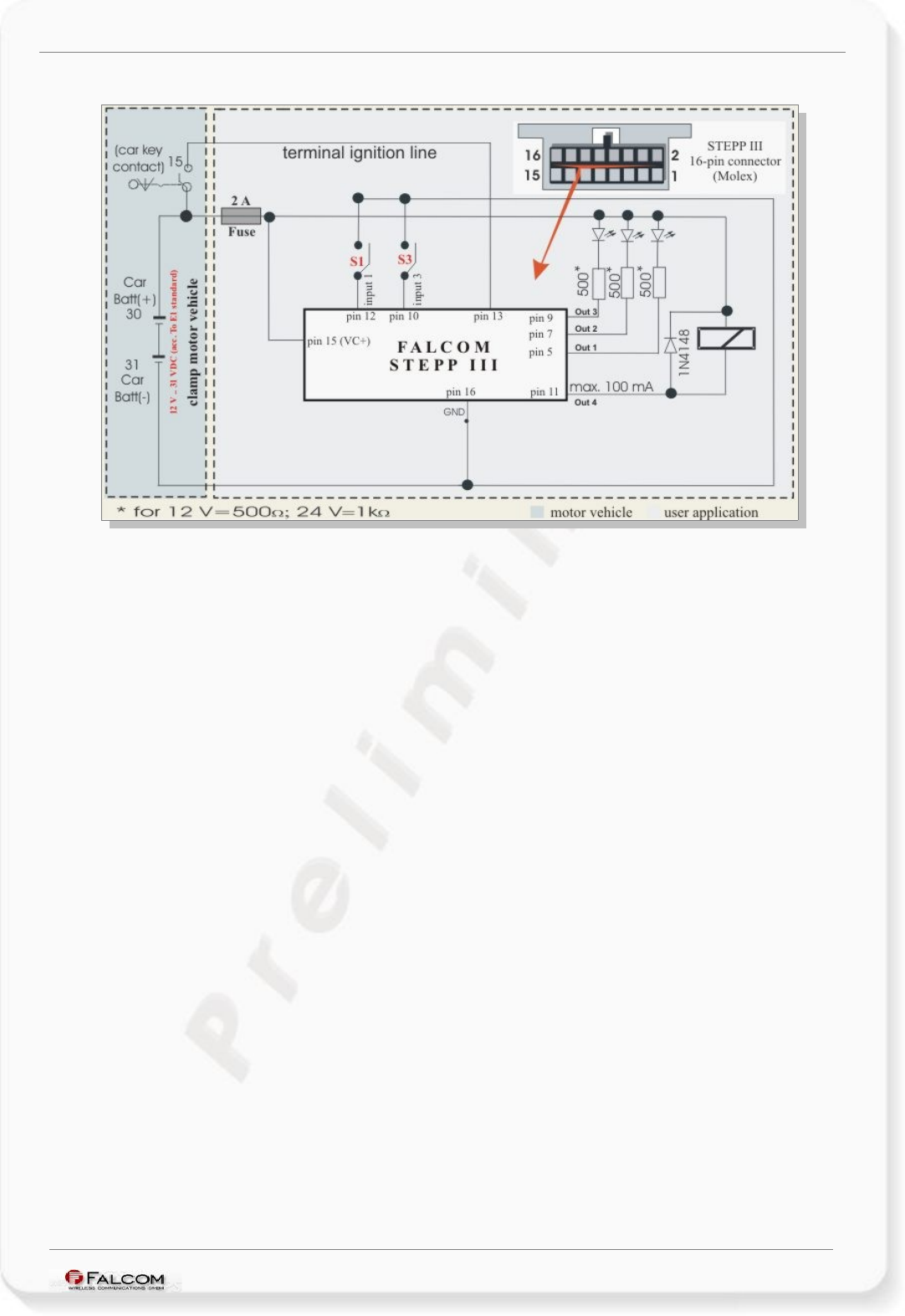
STEPPIII Hardware description Version 1.0.0
Figure 19: Schematic example of installation guidance
This confidential document is a property of FALCOM and may not be copied or circulated without previous permission.
Page 37
